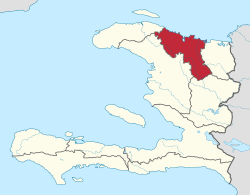Nord (Haitian department)
Nord (Haitian Creole: Nò, English: North) is one of the ten departments of Haiti. It has an area of 2,114.91 km² and a population of 1,067,177 (2015). Its capital is Cap-Haïtien.
Nord Nò | |
|---|---|
 Nord in Haiti | |
| Country | |
| Capital | Cap-Haïtien |
| Government | |
| • Type | Departmental Council |
| Area | |
| • Department | 2,114.91 km2 (816.57 sq mi) |
| Population (2015)[1] | |
| • Department | 1,067,177 |
| • Density | 500/km2 (1,300/sq mi) |
| • Urban | 538,875 |
| • Rural | 528,302 |
| Time zone | UTC-5 (Eastern) |
| ISO 3166 code | HT-ND |
| HDI (2017) | 0.508[2] low · 2nd |
Administrative divisions
The Department of Nord is subdivided into seven arrondissements, which are further subdivided into nineteen communes.
- Acul-du-Nord Arrondissement
- Borgne Arrondissement
- Cap-Haïtien Arrondissement
- Grand-Rivière-du-Nord Arrondissement
- Grande-Rivière-du-Nord
- Bahon
- Limbé Arrondissement
- Plaisance Arrondissement
- Saint-Raphaël Arrondissement
- Saint-Raphaël
- Dondon
- La Victoire
- Pignon
- Ranquitte
History
In 1789 the Nord Department on the northern shore was the most fertile area with the largest sugar plantations. It was an area of vast economic importance. Here most of the slaves lived in relative isolation, separated from the rest of the colony by a high mountain range known as the Massif. This area was a stronghold of the wealthy planters who wanted greater autonomy for the colony, especially economically, so they could do as they pleased.[3]
Although the slaves were not expected to participate in a rebellion, suddenly on August 22, 1791, a great slave uprising plunged the country into civil war. Thousands of slaves in the fertile Nord Department region rose up to take vengeance on their masters and to fight for their liberty. Within the next ten days slaves had taken control of the entire northern province in an unprecedented slave revolt that left the whites controlling only a few isolated fortified camps. Within the next two months as the violence escalated, the rebelling slaves killed 2,000 whites and burned or destroyed 280 sugar plantations.[4] Within a year the island was in revolutionary chaos. Slaves burned the plantations where they had been forced to work, and killed masters, overseers and other whites.[3] This was the beginning of the Haitian Revolution.
In 1804, Haiti declared itself a free republic but civil war broke out in the north under the leadership of Henri Christophe.[3] Christophe declared the northern dominion a kingdom in 1811 and crowned himself King Henry I of Haiti.[5] In 1820, King Henry committed suicide after suffering a stroke that resulted in loss of control of his army and power. The area was re-claimed by Jean-Pierre Boyer, then the appointed president of Haiti, on October 26, 1820 after Haitian forces captured Cap-Haïtien, re-uniting Haiti.[5]
References
- http://www.ihsi.ht/pdf/projection/Estimat_PopTotal_18ans_Menag2015.pdf
- "Sub-national HDI - Area Database - Global Data Lab". hdi.globaldatalab.org. Retrieved 2018-09-13.
- Knight, Franklin W. (1990). The Caribbean: The Genesis of a Fragmented Nationalism (2nd ed.). New York: Oxford University Press. pp. 204–208, 217. ISBN 0-19-505441-5.
- Rogozinski, Jan (1999). A Brief History of the Caribbean (Revised ed.). New York: Facts on File, Inc. pp. 167. ISBN 0-8160-3811-2.
- "haitian history". www.kreyol.com. 2002. Retrieved 2007-08-30.
